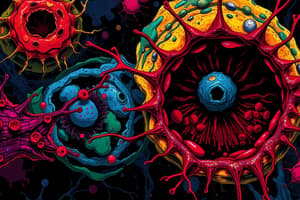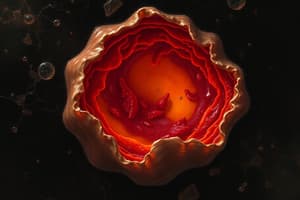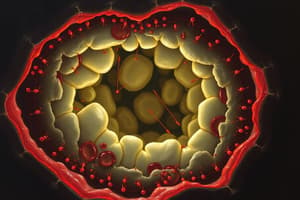Podcast
Questions and Answers
What is the primary purpose of apoptosis in the context of DNA damage?
What is the primary purpose of apoptosis in the context of DNA damage?
- To enhance cell growth and division
- To remove cells that may lead to cancer (correct)
- To repair damaged DNA directly
- To promote mutation through cellular replication
Which of the following is a consequence of thymine dimers on DNA?
Which of the following is a consequence of thymine dimers on DNA?
- They enhance replication accuracy
- They stabilize DNA structure
- They disrupt DNA structure (correct)
- They promote cell division
During apoptosis, which of the following morphological changes does NOT occur?
During apoptosis, which of the following morphological changes does NOT occur?
- Chromatin condenses and fragments
- Cell surface bulges into blebs
- Nuclear envelope disassembles
- Cell size increases significantly (correct)
What role do caspases play in apoptosis?
What role do caspases play in apoptosis?
What initiates the activation of initiator caspases?
What initiates the activation of initiator caspases?
Which of the following best describes 'apoptotic bodies' during apoptosis?
Which of the following best describes 'apoptotic bodies' during apoptosis?
What is the function of executor caspases in the apoptosis process?
What is the function of executor caspases in the apoptosis process?
What typically leads to the formation of 'sunburn cells' in skin keratinocytes?
What typically leads to the formation of 'sunburn cells' in skin keratinocytes?
What can contribute to the development of cancers?
What can contribute to the development of cancers?
What is often found at the center of solid tumors due to insufficient blood supply?
What is often found at the center of solid tumors due to insufficient blood supply?
What role does p53 play in the intrinsic pathway of apoptosis?
What role does p53 play in the intrinsic pathway of apoptosis?
Which of the following is NOT a focus in the study of apoptosis?
Which of the following is NOT a focus in the study of apoptosis?
What is the function of cytochrome c in the intrinsic pathway of apoptosis?
What is the function of cytochrome c in the intrinsic pathway of apoptosis?
What is the overall consequence of mitochondrial outer membrane permeabilization (MOMP)?
What is the overall consequence of mitochondrial outer membrane permeabilization (MOMP)?
Which statement accurately describes the role of mutations in cancer development?
Which statement accurately describes the role of mutations in cancer development?
How does apoptosis differ from necrosis?
How does apoptosis differ from necrosis?
What initiates the caspase cascade in the intrinsic pathway of apoptosis?
What initiates the caspase cascade in the intrinsic pathway of apoptosis?
Which proteins aggregate in the mitochondrial membrane to facilitate apoptosis?
Which proteins aggregate in the mitochondrial membrane to facilitate apoptosis?
What is a significant aspect of how cancer can develop based on cell division and apoptosis?
What is a significant aspect of how cancer can develop based on cell division and apoptosis?
What is the primary trigger for the intrinsic apoptosis pathway?
What is the primary trigger for the intrinsic apoptosis pathway?
What is the role of CAD in DNA fragmentation during apoptosis?
What is the role of CAD in DNA fragmentation during apoptosis?
What initiates the extrinsic pathway of apoptosis?
What initiates the extrinsic pathway of apoptosis?
Which statement correctly describes iCAD's function in apoptosis?
Which statement correctly describes iCAD's function in apoptosis?
The binding of Fas ligand to its receptor leads to the formation of which complex?
The binding of Fas ligand to its receptor leads to the formation of which complex?
What is the primary function of executioner caspases in the apoptosis process?
What is the primary function of executioner caspases in the apoptosis process?
Which family do death receptors belong to in the context of apoptosis?
Which family do death receptors belong to in the context of apoptosis?
How does DNA fragmentation occur during the apoptotic process?
How does DNA fragmentation occur during the apoptotic process?
Which of the following best describes the process of apoptosis activation by cytotoxic T-cells?
Which of the following best describes the process of apoptosis activation by cytotoxic T-cells?
What characterizes apoptosis in contrast to necrosis?
What characterizes apoptosis in contrast to necrosis?
Which statement accurately describes necrosis?
Which statement accurately describes necrosis?
What is a key clinical importance of apoptosis?
What is a key clinical importance of apoptosis?
Which of the following is NOT a trigger for apoptosis?
Which of the following is NOT a trigger for apoptosis?
During which process does apoptosis play a significant role?
During which process does apoptosis play a significant role?
What occurs during necrosis that differs from apoptosis?
What occurs during necrosis that differs from apoptosis?
Which of the following describes the nature of apoptosis?
Which of the following describes the nature of apoptosis?
What is a primary difference between intrinsic and extrinsic pathways in apoptosis?
What is a primary difference between intrinsic and extrinsic pathways in apoptosis?
Flashcards are hidden until you start studying
Study Notes
Teaching Objectives
- Understand the timing and significance of cell death.
- Differentiate between necrosis and apoptosis.
- Define apoptosis and necrosis intracellular pathways.
- Recognize the clinical implications of apoptosis.
Apoptosis vs Necrosis
-
Apoptosis:
- Regulated cell death, occurs in a controlled manner.
- Cells quickly removed without releasing contents.
- Triggers include extrinsic factors (e.g., Fas ligand) and intrinsic factors (e.g., DNA damage).
- Does not invoke an inflammatory response.
-
Necrosis:
- Accidental cell death due to lack of ATP (e.g., hypoxia or ischemia).
- Results from physical damage to cells.
- Contents released, leading to inflammation.
Role of Apoptosis
- Essential in tissue remodeling and development.
- Critical during:
- Metamorphosis in amphibians.
- Limb development in embryos.
- Establishment of the adaptive immune system.
Removal of Damaged Cells
- Apoptosis eliminates cells with excessive DNA damage such as thymine dimers (caused by UVB exposure).
- Thymine dimers can disrupt DNA replication, leading to potential mutations and cancer development.
- Keratinocytes in skin form "sunburn cells" and undergo apoptosis from excessive UV exposure.
Morphological Changes in Apoptosis
- Cells shrink and lose cytoskeletal structure.
- Disassembly of the nuclear envelope and fragmentation of chromatin.
- Formation of membrane-bound "apoptotic bodies."
- Rapid clearance of apoptotic bodies by macrophages with minimal observable dead cells.
Caspases and Their Role
- Caspases, a family of proteases, mediate the apoptosis process.
- Synthesized as inactive precursors; activated by cleavage.
- Initiator caspases: Triggered by external signals, dimerize, and get activated.
- Executor caspases: Activated by initiators to carry out cellular changes associated with apoptosis.
DNA Fragmentation Mechanism
- Executioner caspases cleave iCAD, allowing CAD (specific endonuclease) to fragment DNA.
- Results in ladder-like patterns of DNA fragments due to cleavage between nucleosomes.
Extrinsic Apoptosis Pathway
- Triggered by external signals via death receptors on cell membranes.
- Activation of Fas receptor by Fas ligand leads to the formation of the death-inducing signaling complex (DISC), initiating the caspase cascade.
- Part of the TNF receptor family.
Intrinsic Apoptosis Pathway
- Activated in response to intracellular DNA damage via the p53 pathway.
- p53 facilitates the aggregation of Bax and Bak proteins in the mitochondrial membrane.
- Mitochondrial outer membrane permeabilization leads to cytochrome c release, forming the apoptosome with Apaf1, recruiting initiator caspases and triggering apoptosis.
Apoptosis and Cancer
- Cancers result from uncontrolled cell proliferation owing to mutations.
- An increase in cell division or a decrease in apoptosis contributes to tumor development.
- Tumors often have necrotic cores due to insufficient blood supply.
Summary Points
- Recognize significant differences between necrosis and apoptosis.
- Understand the functional roles of apoptosis in biological processes.
- Comprehend both extrinsic and intrinsic pathways of apoptosis.
- Appreciate the crucial role of survival factors in cell fate.
Studying That Suits You
Use AI to generate personalized quizzes and flashcards to suit your learning preferences.




